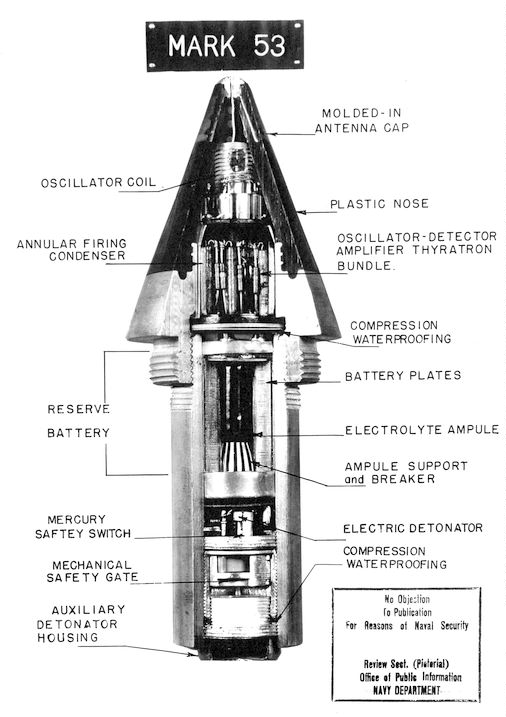
Proximity fuze
A proximity fuze (also VT fuze, or fuse[1][2][3]) is a fuze that detonates an explosive device automatically when it approaches within a certain distance of its target. Proximity fuzes are designed for elusive military targets such as airplanes and missiles, as well as ships at sea and ground forces. This sophisticated trigger mechanism may increase lethality by 5 to 10 times compared to the common contact fuze or timed fuze.[4][5]
Background[edit]
Before the invention of the proximity fuze, detonation was induced by direct contact, a timer set at launch, or an altimeter. All of these earlier methods have disadvantages. The probability of a direct hit on a small moving target is low; a shell that just misses the target will not explode. A time- or height-triggered fuze requires good prediction by the gunner and accurate timing by the fuze. If either is wrong, then even accurately aimed shells may explode harmlessly before reaching the target or after passing it. At the start of The Blitz, it was estimated that it took 20,000 rounds to shoot down a single aircraft;[6] other estimates put the figure as high as 100,000[7] or as low as 2,500.[8] With a proximity fuze, the shell or missile need only pass close by the target at some time during its flight. The proximity fuze makes the problem simpler than the previous methods.
Proximity fuzes are also useful for producing air bursts against ground targets. A contact fuze would explode when it hit the ground; it would not be very effective at scattering shrapnel. A timer fuze can be set to explode a few meters above the ground but the timing is vital and usually requires observers to provide information for adjusting the timing. Observers may not be practical in many situations, the ground may be uneven, and the practice is slow in any event. Proximity fuzes fitted to such weapons as artillery and mortar shells solve this problem by having a range of set burst heights [e.g. 2, 4 or 10 m (7, 13 or 33 ft)] above ground that are selected by gun crews. The shell bursts at the appropriate height above ground.
Sensor types[edit]
Radio[edit]
Radio frequency sensing (radar) is the main sensing principle for artillery shells.
The device described in World War II patent[63] works as follows: The shell contains a micro-transmitter which uses the shell body as an antenna and emits a continuous wave of roughly 180–220 MHz. As the shell approaches a reflecting object, an interference pattern is created. This pattern changes with shrinking distance: every half wavelength in distance (a half wavelength at this frequency is about 0.7 meters), the transmitter is in or out of resonance. This causes a small cycling of the radiated power and consequently the oscillator supply current of about 200–800 Hz, the Doppler frequency. This signal is sent through a band-pass filter, amplified, and triggers the detonation when it exceeds a given amplitude.
Optical[edit]
Optical sensing was developed in 1935, and patented in the United Kingdom in 1936, by a Swedish inventor, probably Edward W. Brandt, using a petoscope. It was first tested as a part of a detonation device for bombs that were to be dropped over bomber aircraft, part of the UK's Air Ministry's "bombs on bombers" concept. It was considered (and later patented by Brandt) for use with anti-aircraft missiles fired from the ground. It used then a toroidal lens, that concentrated all light from a plane perpendicular to the missile's main axis onto a photocell. When the cell current changed a certain amount in a certain time interval, the detonation was triggered.
Some modern air-to-air missiles (e.g. the ASRAAM and AA-12 Adder) use lasers to trigger detonation. They project narrow beams of laser light perpendicular to the flight of the missile. As the missile cruises towards its target the laser energy simply beams out into space. As the missile passes its target some of the energy strikes the target and is reflected to the missile, where detectors sense it and detonate the warhead.
Acoustic[edit]
Acoustic proximity fuzes are actuated by the acoustic emissions from a target (example an aircraft's engine or ship's propeller). Actuation can be either through an electronic circuit coupled to a microphone, or hydrophone, or mechanically using a resonating vibratory reed connected to diaphragm tone filter. [64] [65]
During WW2, the Germans had at least five acoustic fuzes for anti-aircraft use under development, though none saw operational service. The most developmentally advanced of the German acoustic fuze designs was the Rheinmetall-Borsig Kranich (German for Crane) which was a mechanical device utilizing a diaphragm tone filter sensitive to frequencies between 140 and 500Hz connected to a resonating vibratory reed switch used to fire an electrical igniter. The Schmetterling, Enzian, Rheintochter and X4 guided missiles were all designed for use with the Kranich acoustic proximity fuze. [64] [66]
During WW2, the National Defense Research Committee (NDRC) investigated the use of acoustic proximity fuzes for anti-aircraft weapons but concluded that there were more promising technological approaches. The NDRC research highlighted the speed of sound as a major limitation in the design and use of acoustic fuzes, particularly in relation to missiles and high-speed aircraft.[65]
Hydroacoustic influence is widely used as a detonation mechanism for naval mines and torpedoes. A ship's propeller rotating in water produces a powerful hydroacoustic noise which can be picked up using a hydrophone and used for homing and detonation. Influence firing mechanisms often use a combination of acoustic and magnetic induction receivers.[67] [68]

